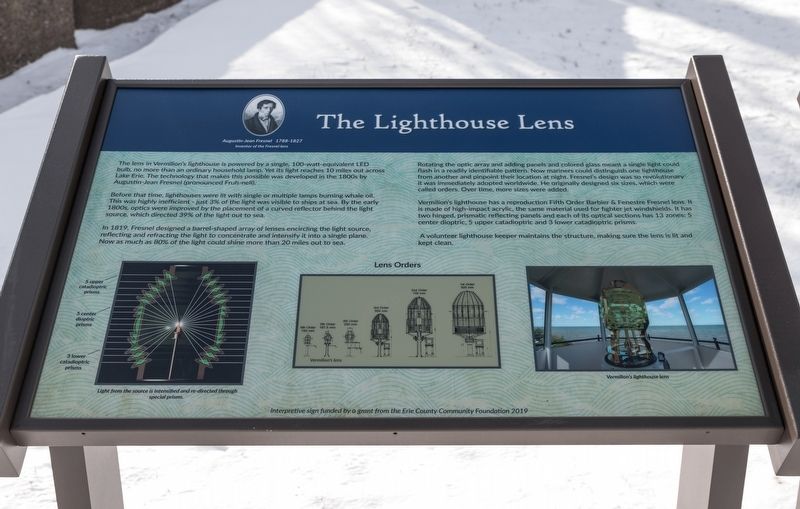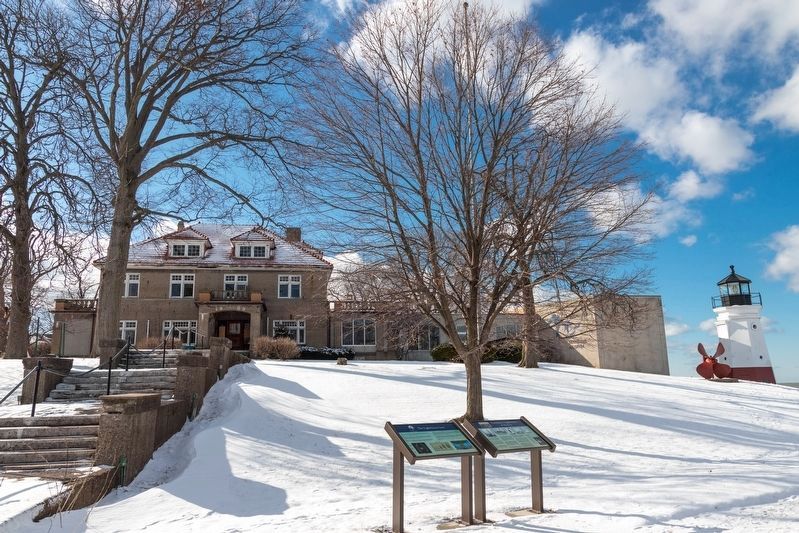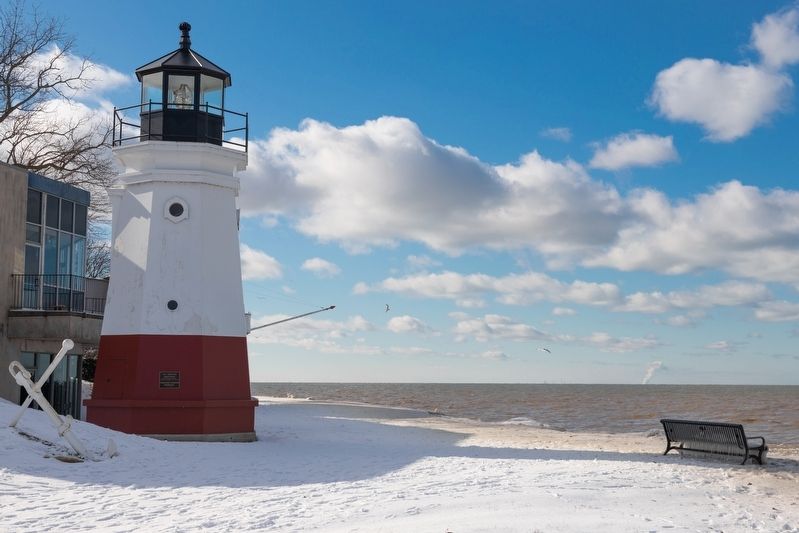Vermilion in Erie County, Ohio — The American Midwest (Great Lakes)
The Lighthouse Lens
The lens in Vermilionís lighthouse is powered by a single, 100-watt-equivalent LED bulb, no more than an ordinary household lamp. Yet its light reaches 10 miles out across Lake Erie. The technology that makes this possible was developed in the 1800s by Augustin-Jean Fresnel (pronounced Fruh-nell).
Before that time, lighthouses were lit with single or multiple lamps burning whale oil. This was highly inefficient—just 3% of the light was visible to ships at sea. By the early 1800s, optics were improved by the placement of a curved reflector behind the light source, which directed 39% of the light out to sea.
In 1819, Fresnel designed a barrel-shaped array of lenses encircling the light source, reflecting and refracting the light to concentrate and intensify it into a single plane. Now as much as 80% of the light could shine more than 20 miles out to sea.
Rotating the optic array and adding panels and colored glass meant a single light could flash in a readily identifiable pattern. Now mariners could distinguish one lighthouse from another and pinpoint their location at night. Fresnelís design was so revolutionary it was immediately adopted worldwide. He originally designed six sizes, which were called orders. Over time, more sizes were added.
Vermilionís lighthouse has a reproduction Fifth Order Barbier & Fenestre Fresnel lens. It is made of high-impact acrylic, the same material used for fighter jet windshields. It has two hinged, prismatic reflecting panels and each of its optical sections has 13 zones: 5 center dioptric, 5 upper catadioptric and 3 lower catadioptric prisms.
A volunteer lighthouse keeper maintains the structure, making sure the lens is lit and kept clean.
Erected by Erie County Community Foundation. (Marker Number 2019.)
Topics and series. This historical marker is listed in these topic lists: Communications • Waterways & Vessels. In addition, it is included in the Lighthouses series list. A significant historical year for this entry is 1819.
Location. 41° 25.48′ N, 82° 21.974′ W. Marker is in Vermilion, Ohio, in Erie County. Marker is on Main Street north of Huron Street, on the left when traveling north. It is at the foot of Main Street in Harbor View Park near the Vermilion lighthouse. Touch for map. Marker is at or near this postal address: 480 Main St, Vermilion OH 44089, United States of America. Touch for directions.
Other nearby markers. At least 8 other markers are within 7 miles of this marker, measured as the crow flies. Vermilionís Lighthouse (here, next to this marker); The Days of Steel Boats (approx. 0.2 miles away); Days of Wooden Ships (approx. 0.2 miles away); Vermilion / Erie County
(approx. ľ mile away); Lake Shore Electric Railway (approx. half a mile away); Lester Allan Pelton (approx. 2.4 miles away); Huron Iron Company Furnace (approx. 2Ĺ miles away); Almon Ruggles, Surveyor of the Firelands / The Unknown Sailor and the Battle of Lake Erie (approx. 6.3 miles away). Touch for a list and map of all markers in Vermilion.
More about this marker. The interpretive panel has four illustrations. On the dark blue title bar is a portrait captioned “Augustin-Jean Fresnel, 1788-1827, inventor of the Fresnel lens.” Across the bottom, left to right: (1) a diagram of a Fresnel lens, showing “5 upper catadioptric prisms, 5 center dioptric prisms, 3 catadipotric prisms” and captioned “Light from the source is intensified and re-directed through special prisms.” (2) Diagrams of each of Fresnelís six lens orders, from the smallest (6th order) at 150 mm through 187.5 mm, 250 mm, 500 mm, 700 mm and concluding with the largest (1st order) at 820 mm. Vermilionís lens, a 5th order lens, is indicated. (3) A photograph captioned “Vermilion's lighthouse lens” in its location on the lighthouse, showing
a sun-lit Lake Erie through the lighthouse windows.
Also see . . . Wikipedia entry for Fresnel Lens. Excerpt:
The design allows the construction of lenses of large aperture and short focal length without the mass and volume of material that would be required by a lens of conventional design. A Fresnel lens can be made much thinner than a comparable conventional lens, in some cases taking the form of a flat sheet. A Fresnel lens can capture more oblique light from a light source, thus allowing the light from a lighthouse equipped with one to be visible over greater distances.(Submitted on April 10, 2020.)
Credits. This page was last revised on May 20, 2020. It was originally submitted on April 10, 2020, by J. J. Prats of Powell, Ohio. This page has been viewed 144 times since then and 9 times this year. Photos: 1, 2. submitted on April 10, 2020, by J. J. Prats of Powell, Ohio. 3. submitted on April 7, 2020, by J. J. Prats of Powell, Ohio.


